Instant thalipeeth recipe with step by step pics. Thalipeeth is a spiced flat bread made from multigrain flour. Thalipeeth makes for a healthy, tasty and nutritious breakfast or snack. You can even pack them in the lunch box. You may find the list of ingredients, a little lengthy. But don’t worry, as the recipe otherwise, is quite easy and simple.
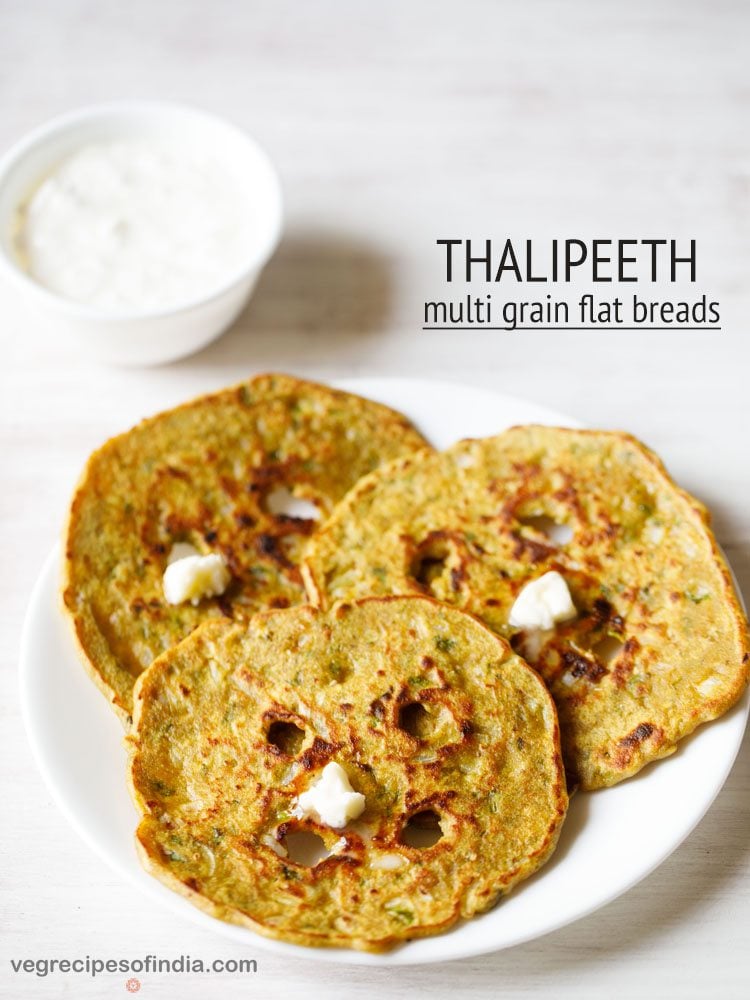
In Maharashtrian homes thalipeeth bhajni is made in large amounts and stored, which is then later used to make thalipeeth. Thalipeeth bhajni is multigrain flour Made with whole grains, millets and spices. Readymade thalipeeth bhajni flour is also available in markets.
The thalipeeth recipe shared here uses various flours to make the mix instantly and then make these spiced flatbreads.
- I have used jowar flour (sorghum flour), atta (whole wheat flour), bajra (pearl millet flour), besan (gram flour) and rice flour.
- You can always add the flours which you have.
- You can even use urad dal flour or ragi flour.
- For a gluten free version skip the whole wheat flour in the recipe and add ¼ cup more of the rice flour.
Just like many other Indian dishes with their variants, even the Thalipeeth Recipe has variations that are made with sabudana or sago/tapioca and rajgira or amaranth flour. These versions are mostly popular during the religious fasting season.
In addition to the flours I have used in this recipe, you can add your choice of flours and make the dish even more healthy.
Thalipeeth is also a street food served in some cities in Maharashtra. The street food version is made with lots of oil, but in the homes thalipeeth is made with less oil. For a low fat version, skip adding oil altogether in the recipe.
Serve thalipeeth hot or warm with some white butter (loni) or curd. You can also serve it with thecha or a pickle. During winter thalipeeth makes for a nice healthy and warming food.
How to make Thalipeeth Recipe
1. In a bowl or pan take ½ cup jowar flour (sorghum flour), ¼ cup whole wheat flour (atta), ½ cup bajra flour (pearl millet flour), ¼ cup besan (gram flour) and ¼ cup rice flour.
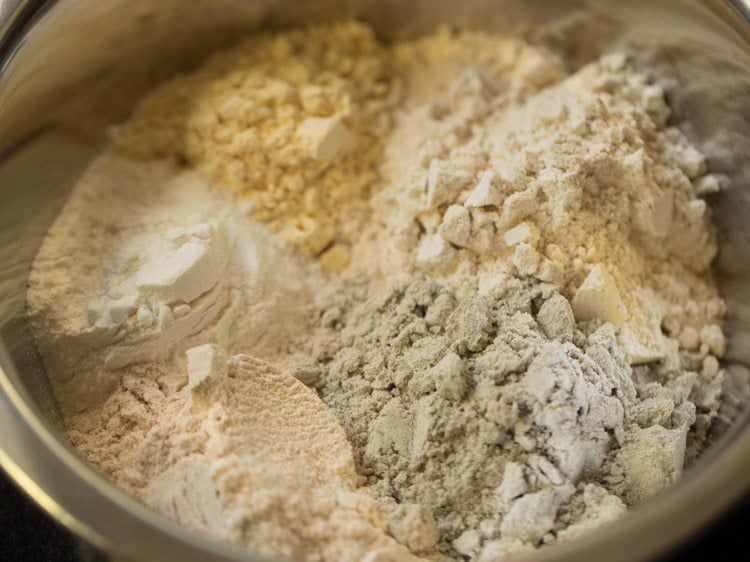
2. Add ¼ teaspoon ajwain (carom seeds), ¼ teaspoon turmeric powder, ¼ teaspoon red chilli powder, ½ teaspoon cumin powder, 1 teaspoon coriander powder, 1 tablespoon sesame seeds and salt as required.
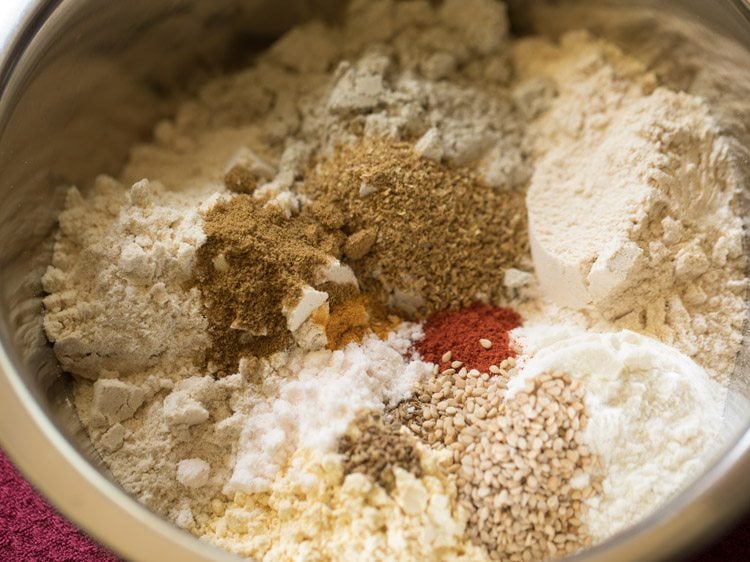
3. Then add ½ cup finely chopped onions, ¼ cup chopped coriander leaves, 1 green chilli (finely chopped) and 1 teaspoon finely chopped ginger.
You can also add 1 teaspoon ginger-garlic paste instead of ginger.
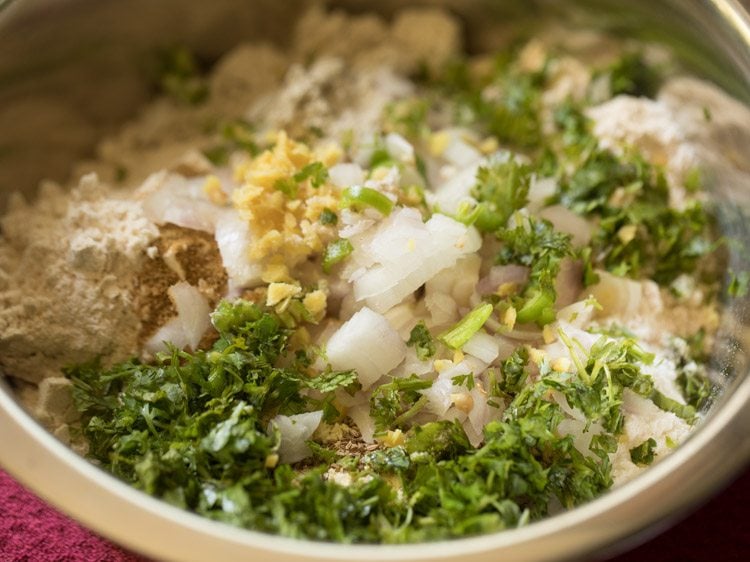
4. Add 1 teaspoon oil.
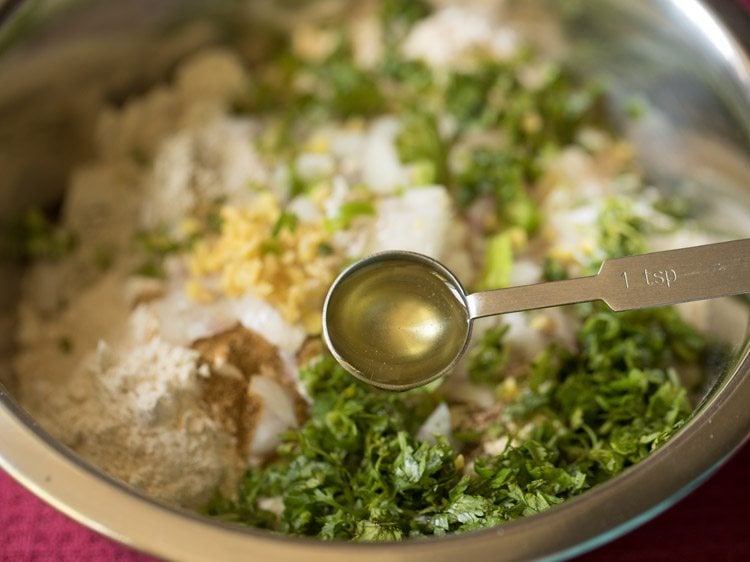
5. Mix everything very well.
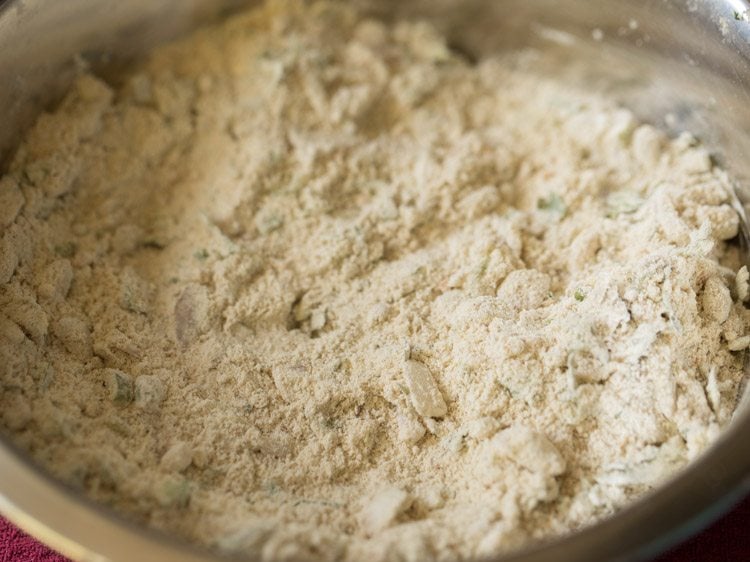
6. Then add water in parts and as required.
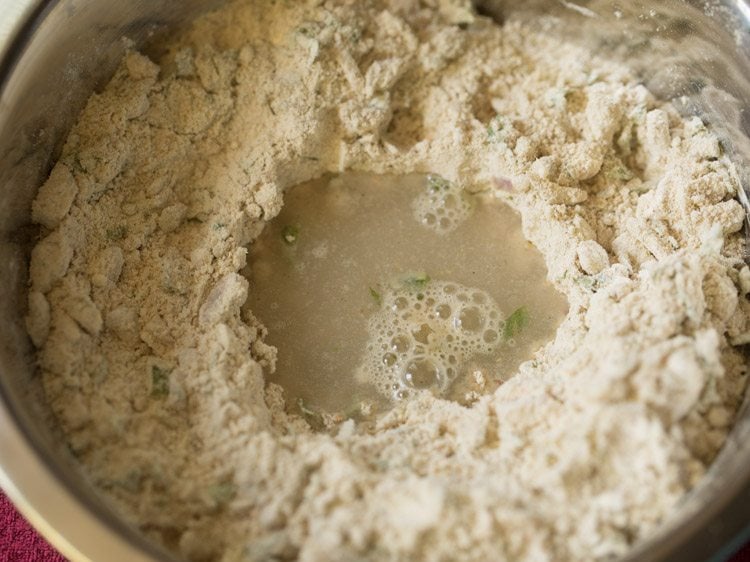
7. Begin to mix the dough.
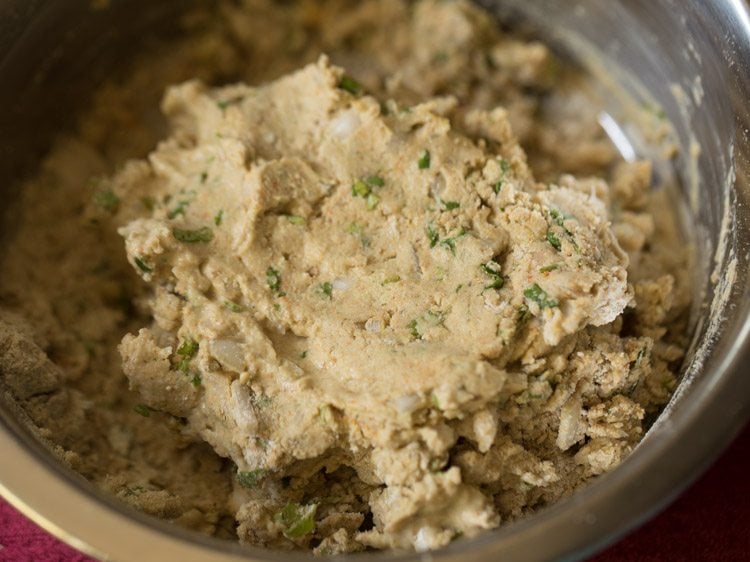
8. Continue to add water in parts and mix everything to a soft and smooth dough. Dough has to manageable, moist and very smooth.
Overall I added ¾ cup + 2 tablespoons water. Depending on the quality and texture of the flour, you can add less or more water.
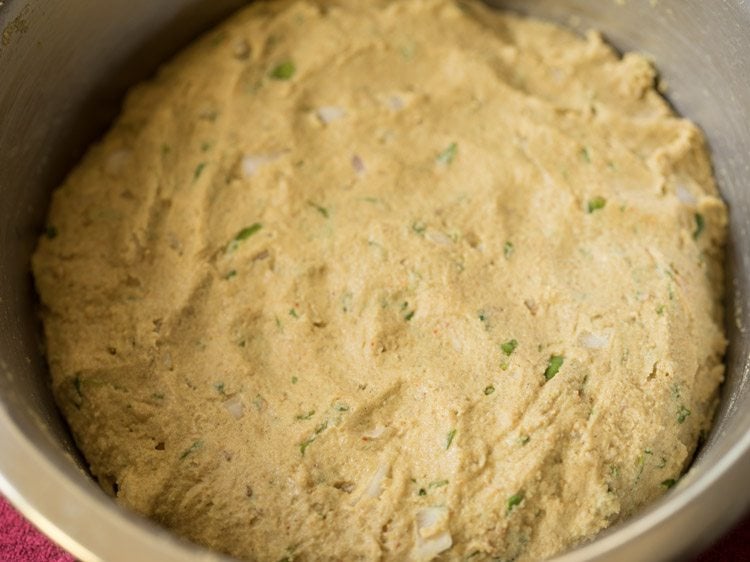
9. Then wet a muslin cloth or a cotton kitchen napkin with water. Wrung the extra water and spread the muslin on the rolling board. The muslin should be moist. Also heat the tawa.
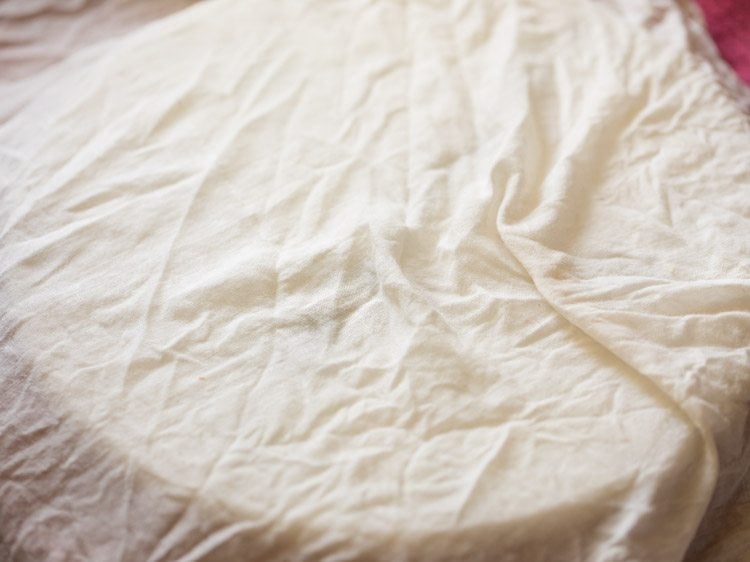
Making thalipeeth
10. Now take a portion of the dough. Roll in your palms and flatten it on the muslin cloth.
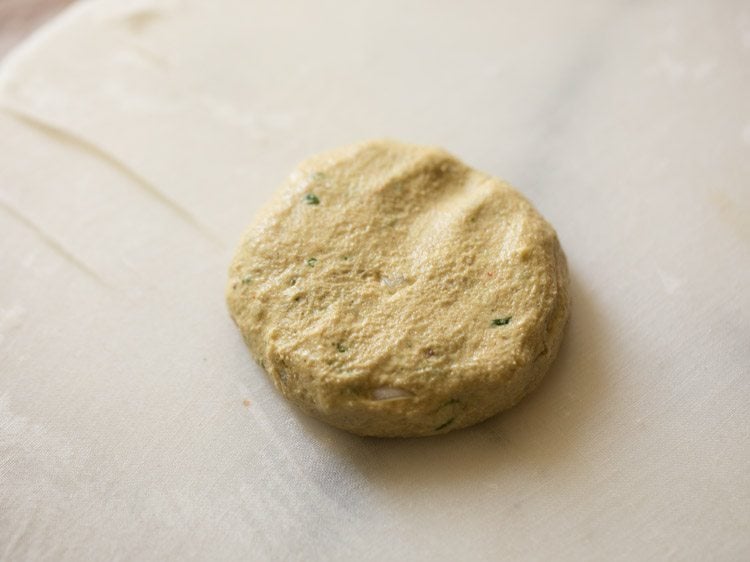
11. With your fingers gently press and flatten the dough to get a flatbread with ¼ inch thickness. While flattening you can sprinkle a few drops of water also on the dough.
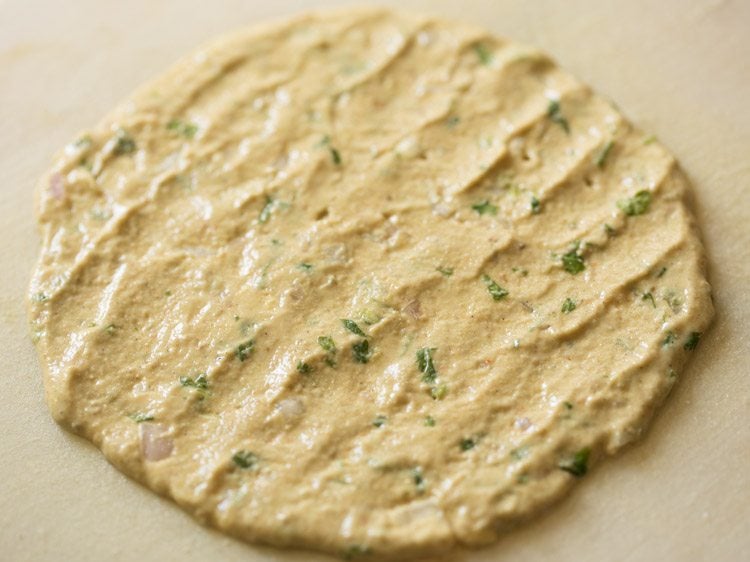
12. Make hole in the center or make 3 to 4 holes at the sides. This helps in frying the thalipeeth well.
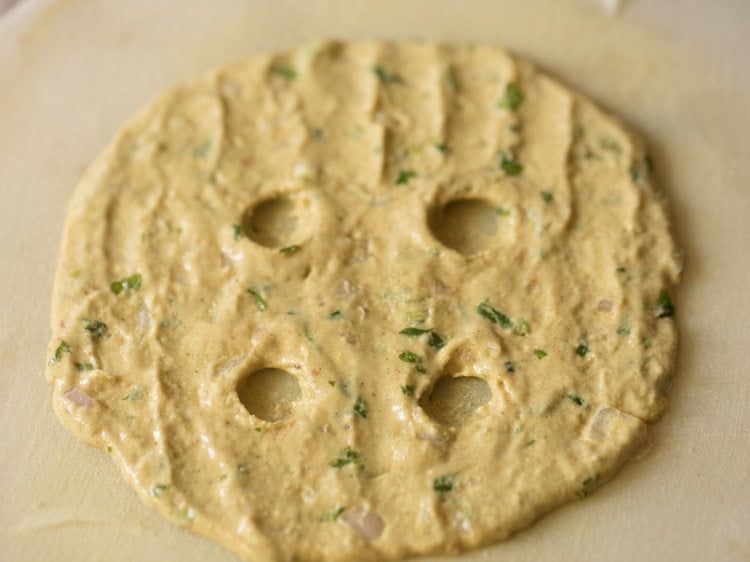
13. Spread some oil on the tawa. The tawa has to be hot. So you can keep it on medium to medium-high flame. Regulate the flame as required.
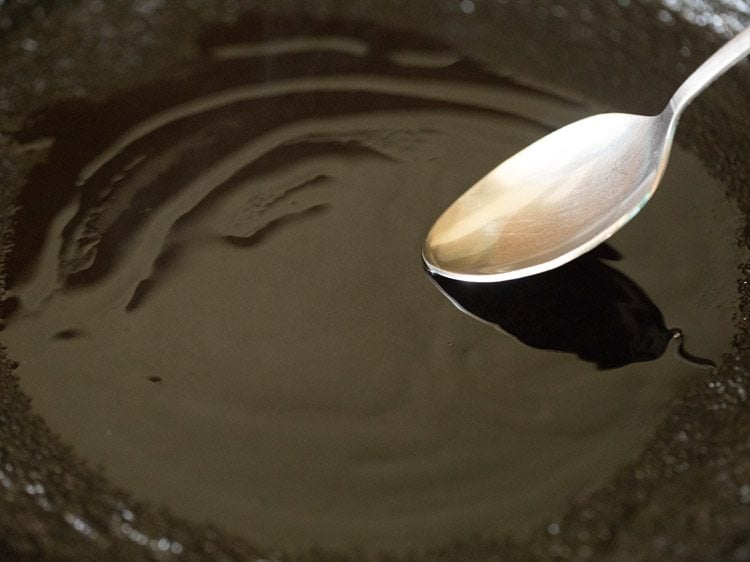
14. Lift the muslin cloth and gently place it with the thalipeeth side touching the tawa.
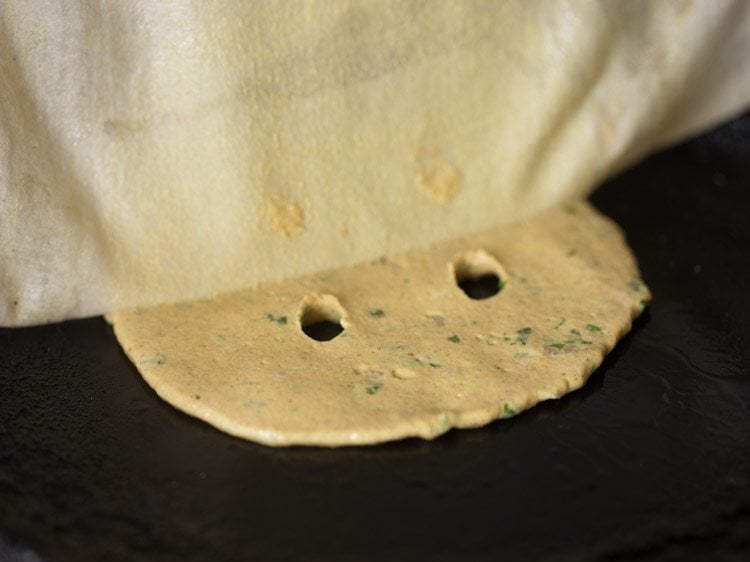
15. Now carefully peel the muslin from the rolled thalipeeth dough.
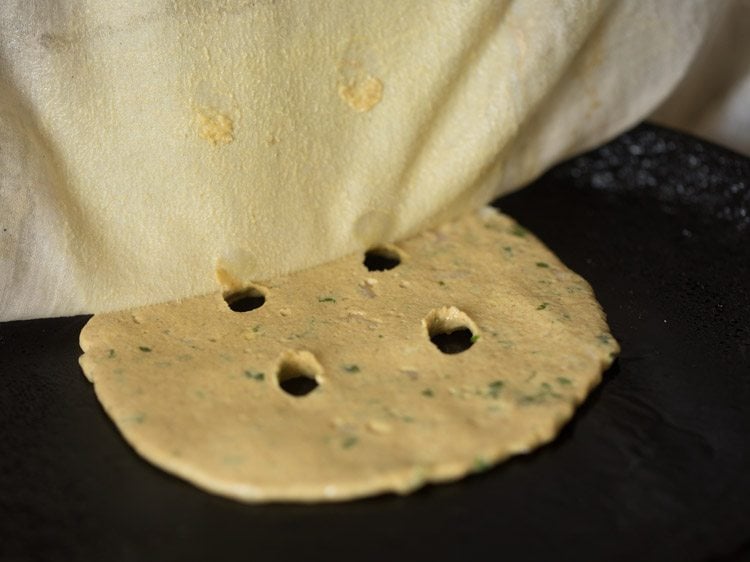
16. Peel carefully and gently as the tawa will be hot.
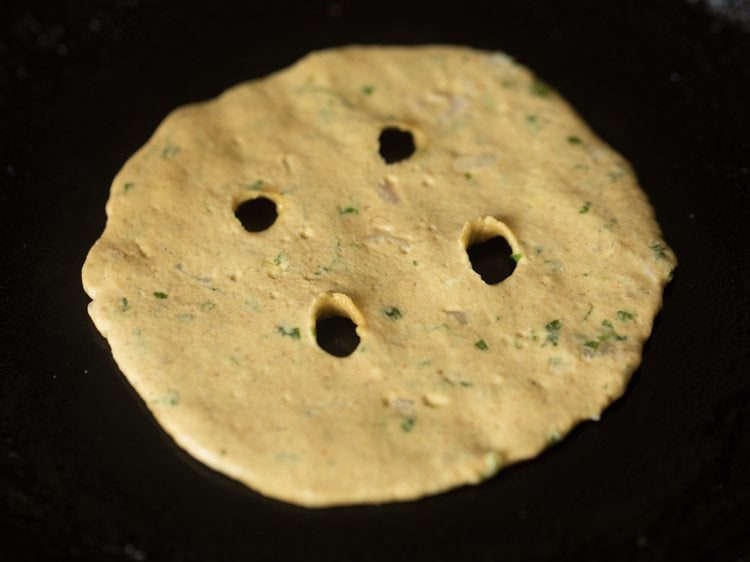
17. Sprinkle some oil in the holes as well as the edges.
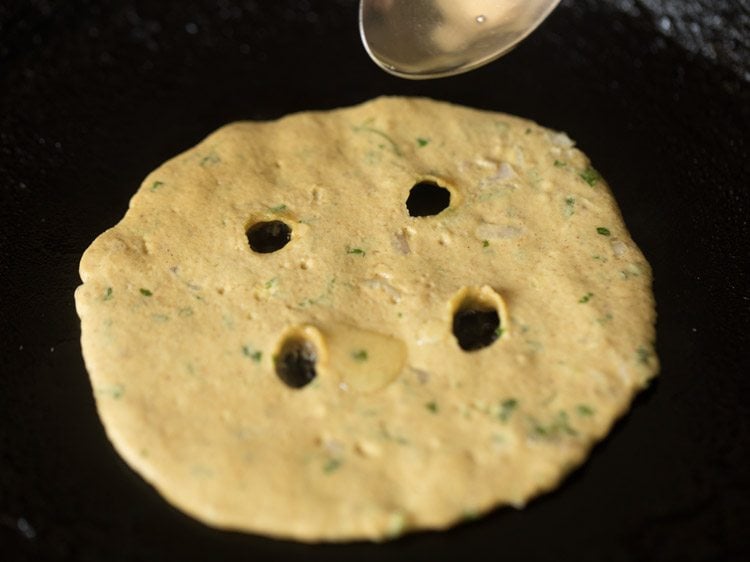
18. Cover with a lid and let the thalipeeth cook for 2 to 3 minutes or till the base is golden and crisp. You can brown the base more if you want.
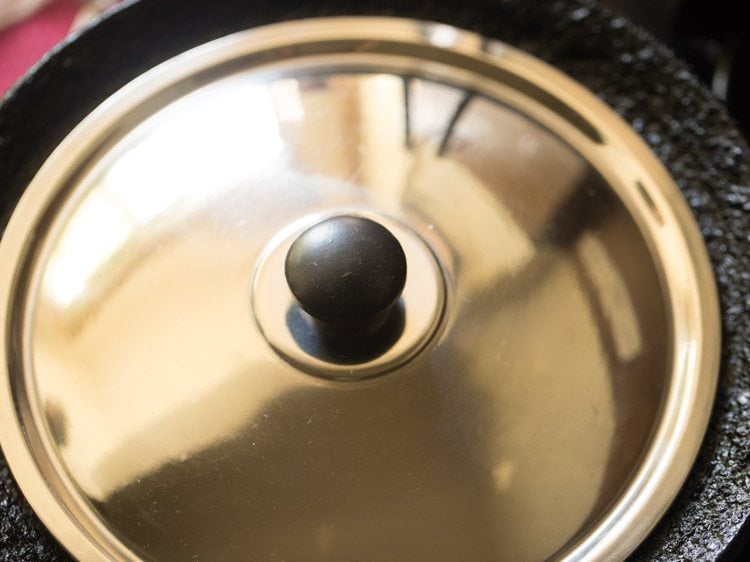
19. The top side will also change in color and texture.
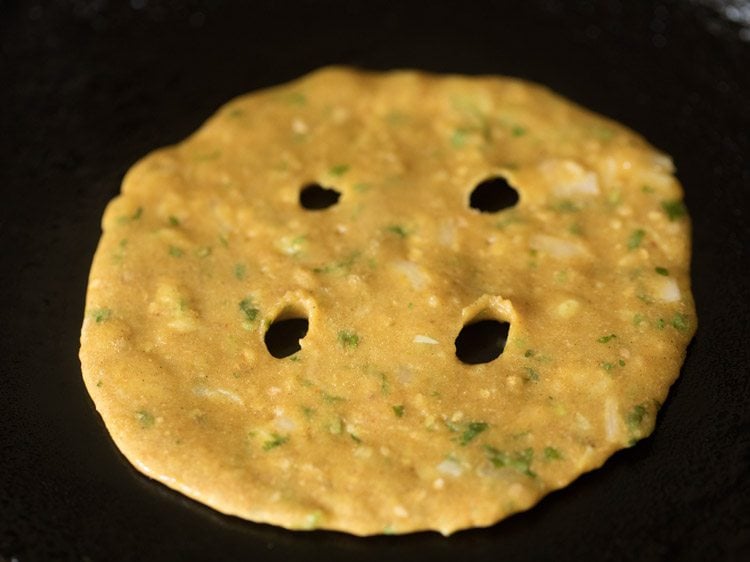
20. Turn over and continue to cook the second side also till you see some brown or charred spots on them.
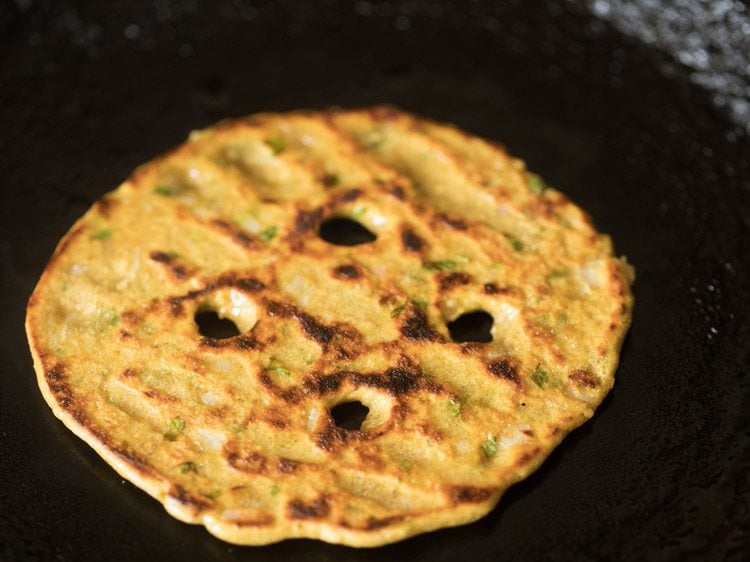
21. Here is the cooked and well roasted second side of the thalipeeth. Remove and serve hot.
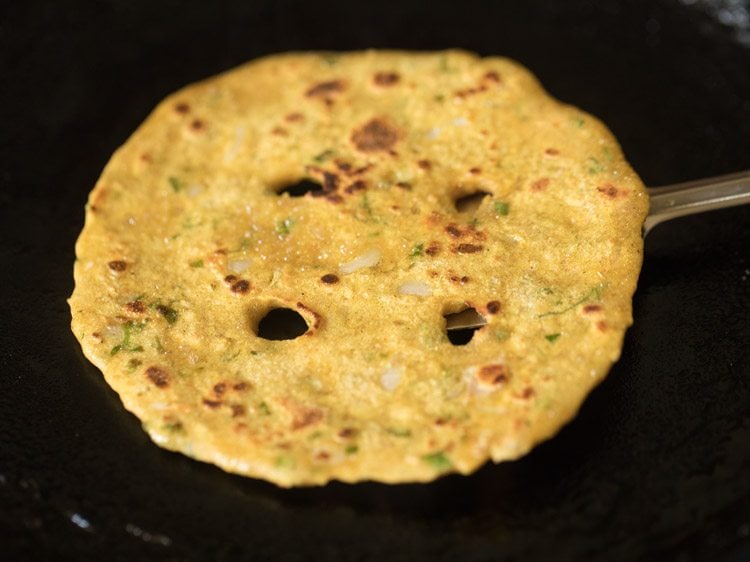
22. If not serving hot, then you can stack the thalipeeth in a roti basket or casserole, so that they stay warm. Prepare all the thalipeeths this way.
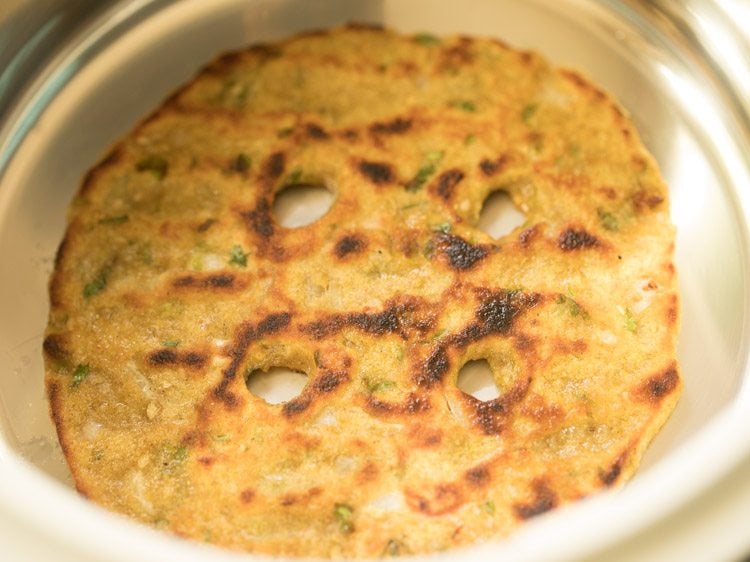
23. Serve thalipeeth recipe with white butter or fresh curd or pickle or thecha.
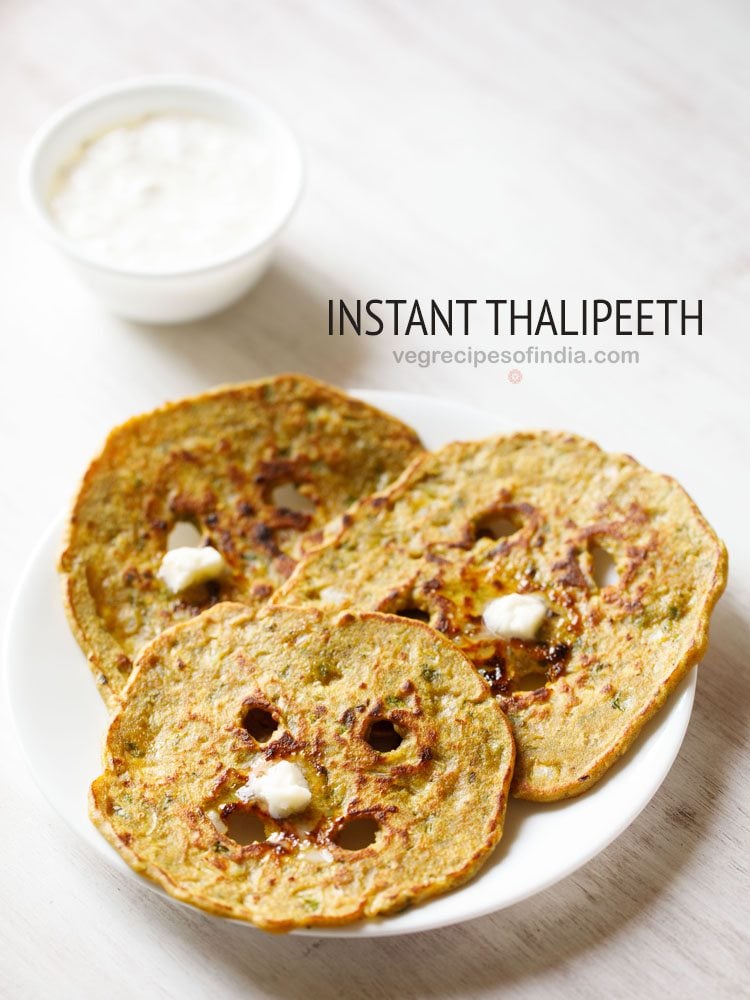
If you are looking for similar recipes then do check:
Please be sure to rate the recipe in the recipe card or leave a comment below if you have made it. For more vegetarian inspirations, Sign Up for my emails or follow me on Instagram, Youtube, Facebook, Pinterest or Twitter.
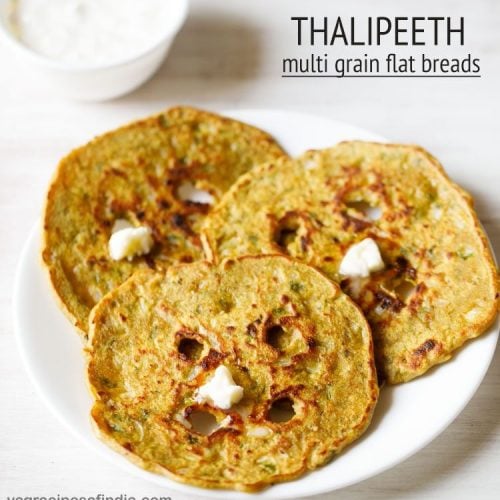
Thalipeeth Recipe
Ingredients
for making thalipeeth dough
- ½ cup jowar (sorghum flour)
- ¼ cup atta (whole wheat flour)
- ½ cup bajra (pearl millet flour)
- ¼ cup besan (gram flour)
- ¼ cup Rice Flour (chawal ka atta)
- ¼ teaspoon ajwain (carom seeds)
- ¼ teaspoon turmeric powder (haldi)
- ¼ teaspoon red chilli powder
- ½ teaspoon cumin powder (jeera powder)
- 1 teaspoon Coriander Powder (dhania powder)
- 1 tablespoon sesame seeds
- 1 medium onion or ½ cup finely chopped onions
- 1 teaspoon finely chopped ginger
- ¼ cup chopped coriander leaves
- 1 green chilli – finely chopped
- 1 teaspoon oil
- salt as required
- ¾ cup + 2 to 3 tablespoons water or add as required
other ingredients
- oil as required for roasting
Instructions
making thalipeeth dough
- First take all the flours, spice powders, carom seeds, sesame seeds, onions, ginger, green chili, coriander leaves and salt in a mixing bowl or pan.
- Add 1 teaspoon oil.
- Mix everything very well.
- Then add water in parts and as required.
- Begin to mix the dough.
- Continue to add water in parts and mix everything to a soft and smooth dough. Dough has to manageable, moist and very smooth. Depending on the quality and texture of the flour, you can add less or more water.
making thalipeeth
- Then wet a muslin cloth or a cotton kitchen napkin with water. Wrung the extra water and spread the muslin on the rolling board. The muslin should be moist. Also heat the tawa.
- Now take a portion of the dough. Roll in your palms and flatten it on the muslin.
- With your fingers gently press and flatten the dough to get a flatbread with ¼ inch thickness. While flattening you can sprinkle a few drops of water also on the dough.
- Make hole in the center or make 3 to 4 holes at the sides. This helps in frying the thalipeeth well.
- Spread a bit of oil on the tawa. The tawa has to hot. So you can keep it on medium to high flame. Regulate the flame as required.
- Lift the muslin cloth and gently place it with the thalipeeth side touching the tawa.
- Now carefully peel the muslin from the rolled thalipeeth dough.
- Sprinkle some oil in the holes as well as the edges.
- Cover with a lid and let the thalipeeth cook for 2 to 3 minutes or till you the base is golden and crisp. You can brown the base more if you want.
- Turn over and continue to cook the second side also till you see some brown or charred spots on them.
- Remove and serve thalipeeth hot.
- If not serving hot, then you can stack the thalipeeth in a roti basket or casserole, so that they stay warm. Prepare all the thalipeeths this way.
- Serve thalipeeth recipe with white butter or fresh curd or pickle or thecha.
Nutrition Info (Approximate Values)
This Thalipeeth Recipe from the archives, originally published in November 2017 has been updated and republished on February 2023.












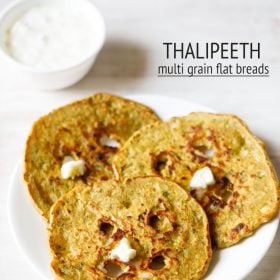
I have tried making thalipeeth today. It’s tasty and delicious
Perfect.
Thank you for the recipe.
Great and thanks for this super feedback.
Is it possible to make without rice flour? In our house, bajra taste is not appreciated much so if I have to skip bajra and use ragi and/or urad flour then how would the proportions vary? Also does it stay soft for longer time? Thanks in advance.
Yes, you can use any flour – does not matter. I also make with ragi flour at times. It does not stay soft for a long time. The softness varies with the proportions and type of flour added. The proportions for replacing bajra flour will be:
Rice flour – total of ½ cup [here you can add ¼ cup (wheat flour) atta more so that it is balanced with the rest of the ingredients like the spices and herbs]
Ragi Flour – ½ cup
Urad flour – ½ cup
Perfect …all of your receipe are perfect and nicely explained… pictures are clear. All Maharashtrian receipe. Very quickly I can check. I googled your vegreceipes first.
thank you tulsi for this lovely comment. so glad to read. thanks again and happy cooking.
Hi Dassana,
Awsome recipe !
Can I make thalipeeth only with wheat flour and besan ? If yes, how much quantity of besan should I use ? Can I add rava in this ?
hi aishwarya, firstly thanks. you can make thalipeeth with besan and wheat flour. you can add rava also. use half cup each of atta and besan. add 2 tablespoons rava. add less water and make the dough. reduce the spices and herbs also. hope this helps.
Hi Dassana,
Thank you so much for adding Thaleepeeth receipe.I always thought why you never added this receipe, Trust me even yesterday I thought the same.
Welcome Vaishali. It was in my mind also for a long time. But you know Indian cuisine is so big to cover, So some good recipes are still not on the blog.